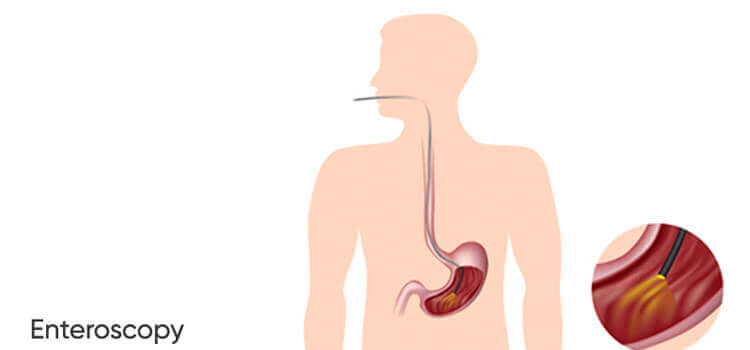
ENTEROSCOPY
Enteroscopy is a procedure to detect & diagnose gastrointestinal disorders. Enteroscopy is also known as Double Balloon Enteroscopy, Capsule Enteroscopy or push & pull Enteroscopy.
During this procedure the doctor inserts an endoscope, a thin tube with a camera on its tip, into the body. Generally, one or two balloons are attached to the endoscope as they help the doctor get a better view once inflated. To collect tissue sample or biopsy, forceps or scissors may be attached to the endoscope.
There are two types of Enteroscopy: Upper Enteroscopy & Lower Enteroscopy. Upper enteroscopy is when the endoscope is inserted into the mouth. In a lower Enteroscopy, the doctor inserts the endoscope into the rectum. The doctor determines whether an upper enteroscopy or lower enteroscopy is required based on the type of problem he may suspect.
Why is an Enteroscopy required?
An enteroscopy is commonly used to diagnose problems in the digestive system and is generally recommended after other imaging tests such as colonoscopy or barium tests revealed a problem in the GI tract. Enteroscopy may be required if the patient has the following signs & symptoms:
- High WBC count
- Suspected tumours in small intestine
- Bleeding in Digestive tract
- Bowel obstruction
- Diarrhoea
- Unexplained malnutrition
- Damage caused to intestines due to radiation treatment
What are the risks involved?
Post procedure, patients may experience certain side effects such as:
- Sore throat
- Bloating
- Nausea
- Bleeding
- Cramps in the abdomen
In rare cases, complications such as pancreatitis, internal bleeding or tear of the lining of small intestine may be reported. Hence, an Enteroscopy is usually not suggested for obese individuals, heart or lung patients and pregnant women
It is best to consult the gastroenterologist immediately if the patient experiences:
- Major bleeding in stools
- Severe pain in the abdomen
- High Fever
- Vomiting
Abnormal Results of Enteroscopy may be indicative of tumours, abnormal tissue or bleeding in the small intestine. Other causes may include:
- An intestinal Virus
- Vitamin B12 deficiency
- Crohn’s disease
- Lymphoma
- Whipple Disease
What to Expect during Cholangioscopy?
The patient would be given a sedative intravenously before the procedure begins. During the procedure, a small tube known as cholangioscope is inserted into the patient’s mouth down the oesophagus through the stomach into the biliary tract. With the help of a cholangioscope, the doctor can diagnose, collect sample and in certain cases treat stones in gallbladder, stones in bile ducts & bile duct strictures. Cholangioscopy is also an important tool for ruling out cancer in the biliary tract.
After the procedure, the patient can go home once the sedative wears off. The patient is advised to follow a diet with only clear liquids such as water, lemonade, tea or coffee without milk for the next 24 hours. The patient can resume his regular activities a day after the surgery unless otherwise instructed by the doctor.
Are there any Side effects?
- Reactions to the sedative : The sedatives used for anesthesia may cause drowsiness, nausea or vomiting.
- Sore Throat is a common side effect. As the endoscope is passed down the oesophagus, it causes tenderness in the throat.
- Gas or Cramps in the abdomen: The doctor may have released a small amount of air into the digestive system to have a clearer view of the organs. This may lead to gas, bloating or cramps after the procedure.




